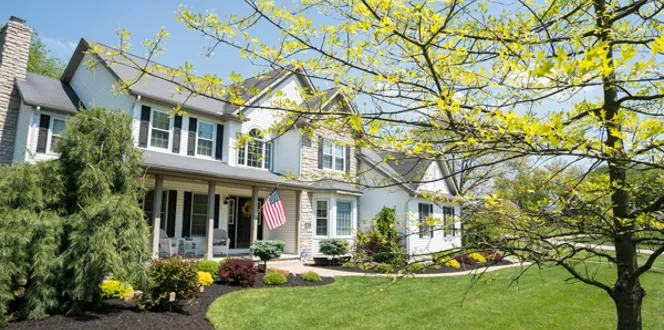If you don’t want to compromise your landscaping but want to add some more privacy and color to your home landscape, trees can be great additions to your property.
Whether you’re seeking narrow trees for a fence line or trees that can create some privacy, you have numerous options that can be both practical and beautiful.
But when you approach a nursery or garden center, you might find the options are endless. Which are the best trees to plant along a fence line for privacy? What are the best small trees for a fence line? What are the greatest narrow trees for a fence line that would fit in your specific climate and conditions?
Here are some of our recommendations for best trees for a fence line to help you in your quest for a more colorful and cozy backyard.
Best Trees For Fence Lines
Try some of these best trees to plant along a fence line for privacy.
Eastern Redcedar
- Description: Eastern redcedar is a great tree for a windbreak, being drought-, heat-, and cold-resistant. It’s tolerant of a wide range of soils, as well as salt, making it great near fence lines that are near roads, driveways, or sidewalks. Plant this tree in full sun.
- Height: This tree can mature at 40 to 50 feet in height with an 8 to 20-foot spread.
- Grow zones: 2 to 9
Rocky Mountain Juniper
- Description: Rocky mountain juniper is native to western North America. It grows in a columnar shape with dark green to blue-green foliage and loves full sun but can take to partial shade. You can use these trees to create both single and multiple windbreaks.
- Height: This tree can typically reach a mature height of 20 to 30 feet with a 8 to 12-foot spread.
- Grow zones: 4 to 9
Arborvitae Thuja
- Description: This versatile, columnar tree is a natural choice for windbreaks, making great hedges or screens. The scale-like leaves are packed closely together in overlapping rows on branches, and they change from bright green in summer to rich green in winter. These trees prefer full sun.
- Height: The American arborvitae tree can grow 40 to 60 feet high with a 10 to 15-foot spread.
- Grow zones: 3 to 7
Italian Cypress
- Description: This tall, columnar evergreen has blue-green needles and is drought-tolerant once established. Add the Italian cypress to your fence line in full sun for a tall vertical accent. It prefers dry conditions so avoid planting it in places with high humidity and rainfall.
- Height: This tree can grow to 60 to 80 feet tall with an 8- to 12-foot spread.
- Grow zones: 7 to 10
Colorado Blue Spruce
- Description: This stunning evergreen adds a silvery, blue-green shade to your landscape. It’s one of the most popular evergreens, growing best in full sun and adapting well to many soil types. It withstands wind better than other spruces and brings privacy and a windbreak to your yard.
- Height: This tree can grow to a height of 50 to 75 feet and a spread of 10 to 20 feet at maturity.
- Grow zones: 2 to 7
Norway Spruce
- Description: This pyramidal-shaped tree can work great for windbreaks. It has dark green needles and can be used on a variety of sites, as long as it’s in full sun. The Norway spruce is supportive to wildlife like song birds.
- Height: The Norway spruce grows to a height of 40 to 60 feet and a spread of 25 to 30 feet.
- Grow zones: 3 to 7
Dress Up Your Fence Line With These Perennials
Sometimes you want to add more than just the best trees for a fence line. Adding perennials can bring some additional color and depth to these areas, creating more interest. Dress up your fence line with one of these options that are popular for their unique blooms, hues, and growth habits.
Forsythia
- Description: This low-maintenance shrub has an upright, arching form and it attracts bees and butterflies. Plant in full to partial sun and moist, well-drained soil. Along a fence line, it will bring lots of golden spring color as a living privacy wall.
- Bloom time: Forsythia is the first sign of spring in many areas with its long branches full of brilliant, yellow blooms in spring.
- Height: This deciduous flowering shrub has a mature size of between 2 to 10 feet tall and 2 to 10 feet wide, based on the variety.
- Grow zones: 5 to 8
Red Twig Dogwood
- Description: Want to add great color in winter in addition to the rest of the year? Red twig dogwood has green stems in spring and summer that trun bright red when foliage drops off in autumn. Creamy, white flowers erupt in spring, followed by berries that ripen from green to white by summer’s end. While red twig dogwoods tolerate partial shade, the red bark is brightest if planted in full sun.
- Height: This deciduous flowering shrub can typically reach 8 feet tall with an 8-foot spread.
- Grow zones: 2 to 8





